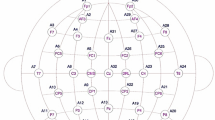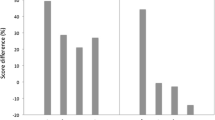Abstract
The spatial distribution of neuronal responses to frequency-modulated (FM) sweeps was mapped with microelectrodes in the primary auditory cortex (AI) of barbiturate-anesthetized cats. Increasing and decreasing FM sweeps (upwardand downward-directed FM sweeps, respectively) covering a range of 0.25–64.0 kHz were presented at three different rates of frequency change over time (i.e., sweep speed). Using multiunit recordings, the high-frequency domain (between 3.2 and 26.3 kHz) of AI was mapped over most of its dorsoventral extent (as determined by the distribution of the excitatory bandwidth, Q10dB) for all six cases studied. The spatial distributions of the preferred sweep speed and the preferred sweep direction were determined for each case. Neuronal responses for frequency sweeps of different speeds appeared to be systematically distributed along the dorsoventral axis of AI. In the dorsal region, cortical cells typically responded best to fast and/or medium FM sweeps, followed more ventrally by cells that responded best to medium — then slow-, then medium-speed FM sweeps. In the more ventral aspect of AI (which in some cases may also have included cells located in the dorsal region of the second auditory field, AII), neurons generally preferred fast FM sweeps. However, a comparison of maps from different animals showed that there was more variability in the distribution of preferred speed responses in the ventral region of the cortex. The directional preference of units for FM sweeps was determined for the sweep speed producing the strongest response. Direction selectivity appeared to be nonrandomly distributed along the dorsoventral axis of AI. In general, units that responded best to upward-directed FM sweeps were located in the more dorsal and ventral aspects of AI while units that responded best to downward-directed FM sweeps were usually located in the mid-region of AI. Direction selectivity was also determined for multiunit responses at each of the three FM sweep speeds. In general, there was a relatively close agreement between the spatial distributions of direction selectivity determined for the strongest response with those calculated for the fast and medium speeds. The spatial distribution of direction selectivity determined for slow FM sweeps deviated somewhat from that determined for the strongest response. Near the dorsoventral center of the mapped areas, the distribution of units that responded best to downward sweeps tended to overlay the distribution of units that responded best to slow speeds, suggesting some spatial covariance of the two parameters. However, when the analysis was extended over the entire region of cortex examined in this study, the point-by-point correlation between preferred speed and direction selectivity was not statistically significant. In addition, when neural responses obtained from the dorsal and ventral subregions were analyzed separately, no significant correlation was observed between these two response parameters. This suggests that, for a given cortical location, the response properties of direction selectivity and preferred speed are derived from distinct neural processing mechanisms. Significant observations were also made between preferred FM sweep speed and excitatory bandwidth (i.e., Q10dB and Q40dB) such that units that responded best to slower FM speeds also seemed to have higher Q10dB and Q40dB (i.e., were narrowly tuned) and vice versa. In addition, units that responded well to a broadband transient stimlus in general preferred faster FM sweeps and vice versa. Although these correlations were significant across the entire dorsoventral extent of AI investigated in this study, they were stronger for responses in the dorsal subregion of AI. For direction selectivity, statistically significant correlations with these response parameters were observed more often in the dorsal than the ventral regions of AI. The apparent spatial segregation of neuronal responses to different FM sweep speeds and sweep directions distributed along the isofrequency domain of AI suggests that the global aspects of cortical function are compatible with psychophysically derived notions of parallel streams of processing for different aspects of FM signals.
Similar content being viewed by others
References
Britt R, Starr A (1976) Synaptic events and discharge patterns of cochlear nucleus. II. Frequency modulated tones. I Neurophysiol 31:179–193
Brugge JF, Merzenich MM (1973) Responses of neurons in auditory cortex of the macaque monkey to monaural and binaural stimulation. J Neurophysiol 36:1138–1158
Clopton BM, Winfield JA (1974) Unit responses in the inferior colliculus of rat to temporal auditory patterns of tone sweeps and noise bursts. Exp Neurol 42:532–540
Edamatsu H, Kawasaki M, Suga N (1989) Distribution of combination-sensitive neurons in the ventral fringe area of the auditory cortex of the mustached bat. J Neurophysiol 61:202–207
Erulkar SD, Butler RA, Gerstein GL (1968) Excitation and inhibition in cochlear nucleus. II. Frequency-modulated tones. J Neurophysiol 31:637–648
Gardner RB, Wilson JP (1979) Evidence for direction-specific channels in the processing of frequency modulation. J Acoust Soc Am 66:704–709
Hubel DH, Wiesel TN (1965) Receptive fields and functional architecture in two non-striate visual areas (18 and 19) of the cat. J Neurophysiol 28:229–289
Imig TJ, Adrian HO (1977) Binaural columns in the primary field (AI) of auditory cortex. Brain Res 138:241–257
Imig TJ, Irons WA, Samson FR (1990) Single-unit selectivity to azimuthal direction and sound pressure level of noise burst in cat high-frequency primary auditory cortex. J Neurophysiol. 63:1448–1466
Kay RH (1982) Hearing of modulation in sounds. Physiol Rev 62:894–975
Kay RH, Matthews DR (1972) On the existence in human auditory pathways of channels selectively tuned to the modulation present in frequency-modulated tones. J Physiol (Lond) 225:657–677
Makela JP, Hari R, Linnankivi A (1987) Different analysis of frequency and amplitude modulations of a continuous tone in the human auditory cortex: a neuromagnetic study. Hear Res 27:257–264
Mendelson JR, Cynader MS (1985) Sensitivity of cat primary auditory cortex (AI) neurons to the direction and rate of frequency modulation. Brain Res 327:331–335
Mendelson JR, Grasse KL (1992) FM sweep selectivity in cat primary auditory cortex: a comparison of monaural and binaural responses in single units. Exp Brain Res 91:435–454
Merzenich MM, Knight PL, Roth GL (1975) Representation of cochlea within primary auditory cortex in the cat. J Neurophysiol 38:231–249
Middlebrooks JC, Dykes RW, Merzenich MM (1980) Binaural response-specific bands in primary auditory cortex (AI) of the cat: topographical organization orthogonal to isofrequency contours. Brain Res 181:31–48
Moller AR (1974) Coding of sounds with rapidly varying spectrum in the cochlear nucleus. J Acoust Soc Am 55:631–640
Mountcastle VB (1957) Modality and topographic properties of single neurons of cat's somatic sensory cortex. J Neurophysiol 20:408–434
Mountcastle VB (1978) In: Edelmann GM, Mountcastle VB (eds) The mindful brain: cortical organization and the group selective theory of higher brain function. MIT, Cambridge
Nomoto M (1980) Discharge patterns of the primary auditory cortex in cats. Jpn J Physiol 30:427–442
O'Neill WE, Suga N (1982) Encoding of target range information and its representation in the auditory cortex of the mustached bat. J Neurosci 47:225–255
Phillips DP, Hall SE (1987) Responses of single neurons in cat auditory cortex to time-varying stimuli: Linear amplitude modulations. Exp Brain Res 67:479–492
Phillips DP, Mendelson J, Cynader MS, Douglas RM (1985) Responses of single neurones in cat auditory cortex to time-varying stimuli: frequency-modulated tones of narrow excursion. Exp Brain Res 58:443–454
Pick GF (1979) A study of frequency transition in cat vocalization. J Acoust Soc Am 66:594–597
Poon PWF, Chen X, Hwang JC (1991) Basic determinants for FM responses in the inferior colliculus of rats. Exp Brain Res 83:598–606
Rajan R, Aitkin LM, Irvine DRF (1990) Azimuthal sensitivity of neurons in primary auditory cortex of cats. II Organization along frequency-band strips. J Neurophysiol 64:888–902
Reale RA, Imig TJ (1980) Tonotopic organization in cat auditory cortex. J Comp Neurol 192:265–292
Reale RA, Kettner RE (1986) Topography of binaural organization in primary auditory cortex of the cat: effects of changing interaural intensity. J Neurophysiol 56:663–682
Rees A, Moller AR (1983) Responses of neurons in the inferior colliculus of the rat to AM and FM tones. Hear Res 10:301–330
Regan D, Tansley BW (1979) Selective adaptation to frequencymodulated tones: Evidence for an information-processing channel selectively sensitive to frequency changes. J Acoust Soc Am 65:1249–1257
Rose JE, Woolsey CN (1948) Structure and relations of limbic cortex and anterior thalamic nuclei in rabbit and cat. J Comp Neurol 89:279–348
Scheich H, Bonke BA (1981) Tone-versus FMinduced patterns of excitation and suppression in the 14- C-2-deoxyglucose labelled auditory “cortex” of the Guinea Fowl. Exp Br Res 44:445–449
Schreiner CE, Cynader MS (1984) Basic functional organization of second auditory cortical field (AII) of the cat. J Neurophysiol 51:1284–1305
Schreiner CE, Langner G (1988) Periodicity coding in the inferior colliculus of the cat. II. Topographical organization. J Neurophysiol 60:1823–1840
Schreiner CE, Mendelson JR (1990) Functional topography of cat primary auditory cortex: distribution of integrated excitation. J Neurophysiol 64:1442–1459
Schreiner CE, Urbas JV (1986) Representation of amplitude in the auditory cortex of the cat. I. The anterior auditory field (AAF). Hear Res 21:227–241
Schreiner CE, Urbas JV (1988) Representation of amplitude in the auditory cortex of the cat. II. Comparison between cortical fields. Hear Res 32:49–64
Schreiner CE, Mendelson JR, Sutter, ML (1992) Functional topography of cat primary auditory cortex: representation of tone intensity. Exp Brain Res 92:105–122
Shore SE, Nuttall AL (1985) High-synchrony cochlear compound action potentials evoked by rising frequency-swept tone bursts. J Acoust Soc Am 78:1286–1295
Shore SE, Clopton BM, Au YN (1987) Unit responses in ventral cochlear nucleus reflect cochlear coding of rapid frequencysweeps. J Acoust Soc Am 82:471–478
Sinex DG, Geisler CD (1981) Auditory-nerve fiber responses to frequency-modulated tones. Hear Res 4:127–148
Suga N (1965a) Functional properties of auditory neurones in the cortex of echo-locating bats. J Physiol 181:671–700
Suga N (1965b) Analysis of frequency modulated sounds by auditory neurons of echo-locating bats. J Physiol (Lond) 179:26–53
Suga N (1968) Analysis of frequency-modulated and complex sounds by single auditory neurones of bats. J Physiol (Lond) 198:51–80
Suga N (1969) Classification of inferior collicular neurones of bats in terms of responses to pure tones, FM sounds, and noise bursts. J Physiol (Lond) 200:555–574
Sutter M, Schreiner CE (1991) Physiology and topography of neurons with multipeaked tuning curves in cat primary auditory cortex. J Neurophysiol 65:1207–1226
Tansley BW, Regan D (1979) Separate auditory channels for unidirectional frequency modulation and unidirectional amplitude modulation. Sensory Proc 3:132–140
Tsuzuki K, Suga N (1988) Combination-sensitive neurons in the ventroanterior area of the auditory cortex of the mustached bat. J Neurophysiol 60:1908–1923
Vartanian IA (1974) On mechanisms of specialized reactions of central auditory neurons to frequency-modulated sounds. Acustica 31:305–310
Watanabe T (1972) Fundamental study of the neural mechanism in cats subserving the feature extraction process of complex sounds. Jpn J Physiol 22:569–583
Whitfield IC, Evans EF (1965) Responses of auditory cortical neurons to stimuli of changing frequency. J Neurophysiol 28:655–672
Whitfield IC, Purser D (1972) Microelectrode study of the medial geniculate body in unanaesthetized free-moving cats. Brain Behav Evol 6:311–322
Woolsey CN, Walzl EM (1942) Topical projection of nerve fibers from local regions of the cochlea in the cerebral cortex of the cat. Bull Johns Hopkins Hosp 71:315–344
Author information
Authors and Affiliations
Rights and permissions
About this article
Cite this article
Mendelson, J.R., Schreiner, C.E., Sutter, M.L. et al. Functional topography of cat primary auditory cortex: responses to frequency-modulated sweeps. Exp Brain Res 94, 65–87 (1993). https://doi.org/10.1007/BF00230471
Received:
Accepted:
Issue Date:
DOI: https://doi.org/10.1007/BF00230471




